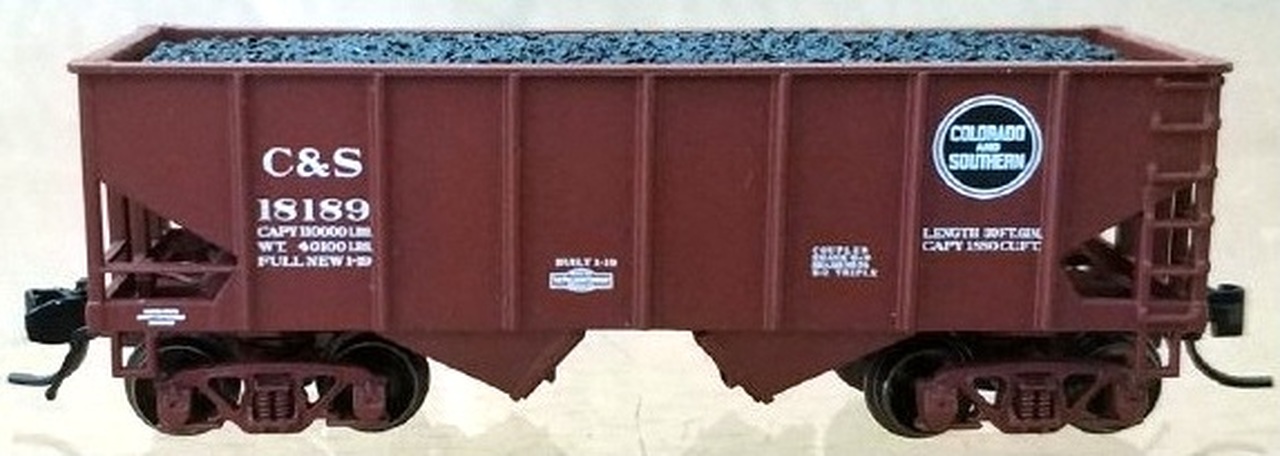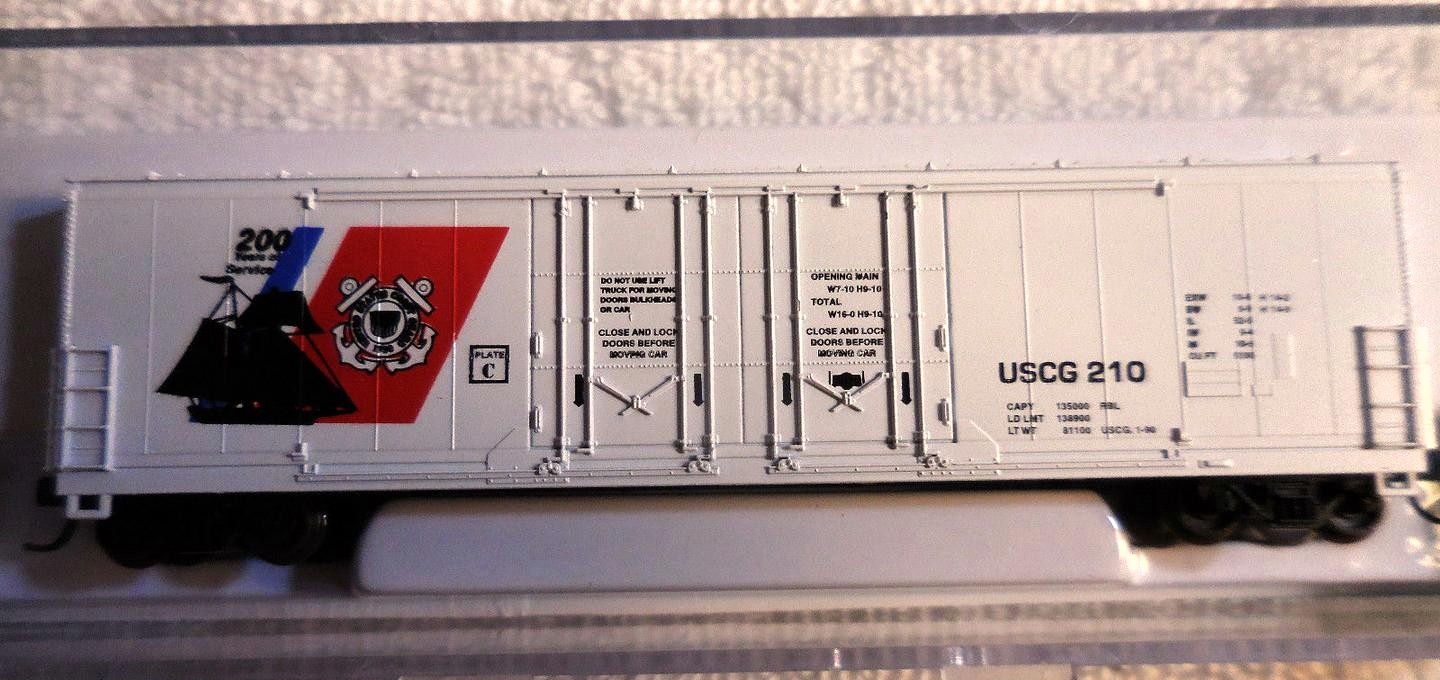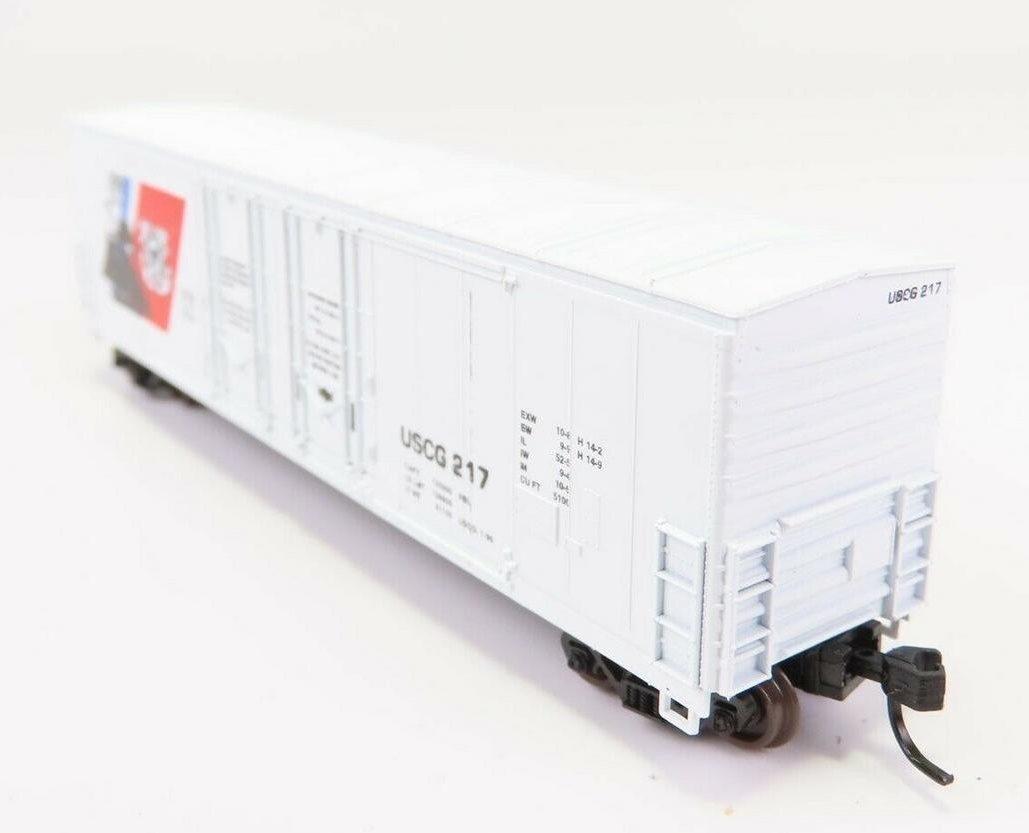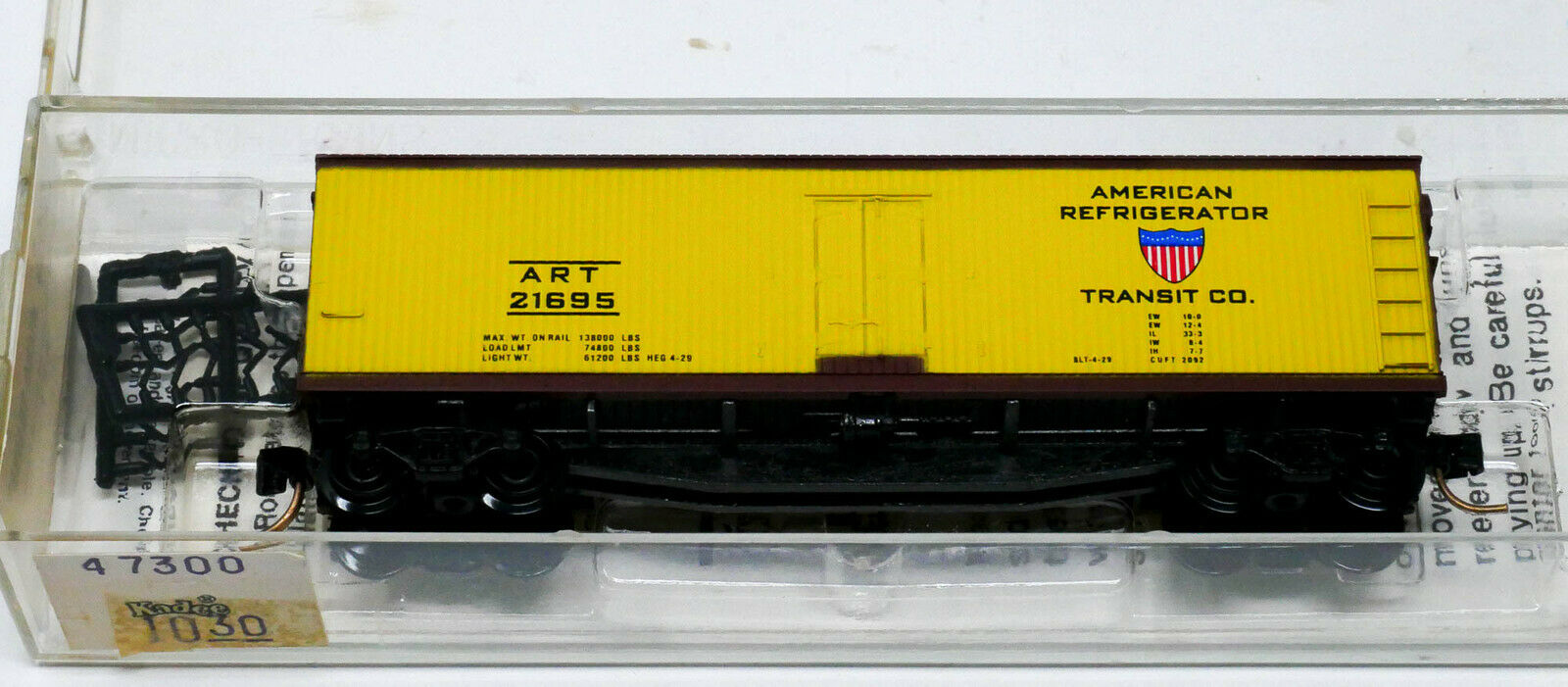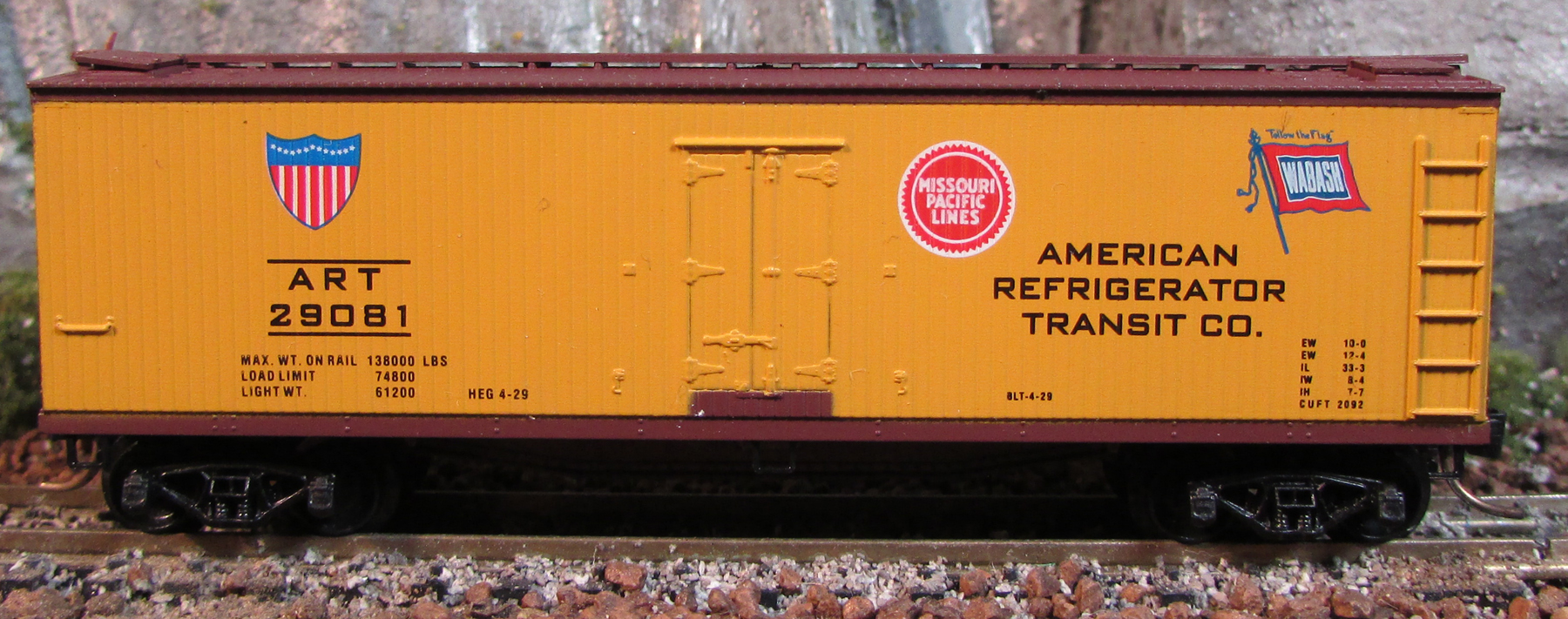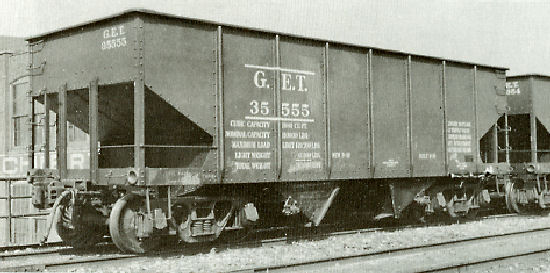Model Information: These ready-to-run cars feature: die cast slope sheet-hopper bay-center sill assembly; injection molded plastic sides, ends, and hopper doors; fully molded brake tank, valve and air lines; body mounted brake hose detail; coal load; lever-style hand brake; body mounted magnetically operating knuckle couplers; close coupling; and Fox Valley Models metal wheels.
Prototype History: The USRA 55-Ton hopper was designed by the United States Railway Administration during World War I as a standardized hopper to be used by all railroads in order to aid the war effort. After WWI many railroads continued to use the USRA 55-Ton hoppers, as well as build many thousands more clones. The USRA hopper was in use on North American railroads from 1918 until the 1970’s
Road Name History: 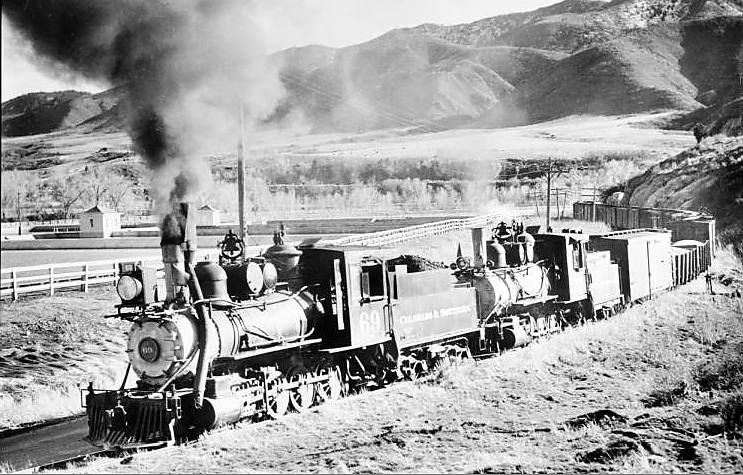 C&S was formed in 1898 with the consolidation of the Union Pacific Denver & Gulf and the Denver Leadville & Gunnison, both of whom had been under the control of Union Pacific prior to falling into receivership. C&S was best known for their 3’ gauge lines built westward from Denver by the Colorado Central (the so called “Clear Creek Lines” to Black Hawk, Central City, and Georgetown including the famous Georgetown Loop) and the Denver South Park & Pacific (southwest to Como, Climax, Leadville and for a short time, Gunnison.) However, the narrow gauge portion was a small fraction of the Colorado & Southern system.
C&S was formed in 1898 with the consolidation of the Union Pacific Denver & Gulf and the Denver Leadville & Gunnison, both of whom had been under the control of Union Pacific prior to falling into receivership. C&S was best known for their 3’ gauge lines built westward from Denver by the Colorado Central (the so called “Clear Creek Lines” to Black Hawk, Central City, and Georgetown including the famous Georgetown Loop) and the Denver South Park & Pacific (southwest to Como, Climax, Leadville and for a short time, Gunnison.) However, the narrow gauge portion was a small fraction of the Colorado & Southern system.
The standard gauge portion started from a point north of Wendover, Wyoming south through Cheyenne, Denver, Colorado Springs, Pueblo, Trinidad and on to Texline on the New Mexico – Texas border. There they connected with their subsidiary Fort Worth & Denver City Railway to Fort Worth and other Texas cities. C&S also controlled the Trinity & Brazos Valley which gave them friendly connections all the way to the port of Galveston. (We’ll cover the FW&D, T&BV and other C&S subsidiaries on future RRotD’s.) The mainline also included the famous “joint line” used by C&S, Santa Fe, and Rio Grande between Denver and Pueblo.
In 1908, Chicago Burlington & Quincy (who connected with C&S in Denver, Cheyenne and Wendover) bought about two thirds of C&S shares and took control. CB&Q was jointly controlled by Great Northern and Northern Pacific and the goal was to secure a through route from the Pacific Northwest to the Gulf of Mexico. C&S adopted CB&Q practices for steam locomotive designs and before long the “Burlington Route” shield appeared on tenders but with C&S lettering on the cabs. Other than that, C&S and FW&D were left to manage their own affairs to a large extent.
In 1937, the old South Park narrow gauge mainline was abandoned leaving only a short stub between Climax and Leadville to connect a molybdenum mine to a standard gauge Rio Grande branch. Four years later, the Clear Creek lines were abandoned and the Climax branch was standard gauged bringing an end to all C&S narrow gauge operations. The Climax branch would go on to host the last regular standard gauge freight service with a steam locomotive by a Class 1 railroad. 2-8-0 #641 would last drop its fire on October 11, 1962.
C&S pressed on through the diesel era with locomotives in CB&Q and later successor Burlington Northern paint but sub-lettered for C&S. Colorado & Southern was finally merged into Burlington Northern on the last day of 1981.

The standard gauge portion started from a point north of Wendover, Wyoming south through Cheyenne, Denver, Colorado Springs, Pueblo, Trinidad and on to Texline on the New Mexico – Texas border. There they connected with their subsidiary Fort Worth & Denver City Railway to Fort Worth and other Texas cities. C&S also controlled the Trinity & Brazos Valley which gave them friendly connections all the way to the port of Galveston. (We’ll cover the FW&D, T&BV and other C&S subsidiaries on future RRotD’s.) The mainline also included the famous “joint line” used by C&S, Santa Fe, and Rio Grande between Denver and Pueblo.
In 1908, Chicago Burlington & Quincy (who connected with C&S in Denver, Cheyenne and Wendover) bought about two thirds of C&S shares and took control. CB&Q was jointly controlled by Great Northern and Northern Pacific and the goal was to secure a through route from the Pacific Northwest to the Gulf of Mexico. C&S adopted CB&Q practices for steam locomotive designs and before long the “Burlington Route” shield appeared on tenders but with C&S lettering on the cabs. Other than that, C&S and FW&D were left to manage their own affairs to a large extent.
In 1937, the old South Park narrow gauge mainline was abandoned leaving only a short stub between Climax and Leadville to connect a molybdenum mine to a standard gauge Rio Grande branch. Four years later, the Clear Creek lines were abandoned and the Climax branch was standard gauged bringing an end to all C&S narrow gauge operations. The Climax branch would go on to host the last regular standard gauge freight service with a steam locomotive by a Class 1 railroad. 2-8-0 #641 would last drop its fire on October 11, 1962.
C&S pressed on through the diesel era with locomotives in CB&Q and later successor Burlington Northern paint but sub-lettered for C&S. Colorado & Southern was finally merged into Burlington Northern on the last day of 1981.
Brand/Importer Information: Bluford Shops began in 2007 as a side project of two model railroad industry veterans, Craig Ross and Steve Rodgers. They saw a gap between road names available on N scale locomotives but not available on cabooses. They commissioned special runs of Atlas cabooses in Atlantic Coast Line, Central of Georgia, Monon, Boston & Maine and Southern plus runs on Grand Trunk Western and Central Vermont on the MDC wooden cabooses. While these were in process, they began to develop their first all new tooling project, 86' Auto Parts Boxcars in double door and quad door editions in N scale. By January of 2008, Bluford Shops became a full time venture. Along with additional N scale freight cars and their own tooling for new cabooses, they have brought their own caboose line to HO scale. They also have their popular Cornfields in both HO and N. The future looks bright as they continue to develop new products for your railroad.
The town of Bluford in southern Illinois featured a small yard on Illinois Central's Edgewood Cutoff (currently part of CN.) The yard included a roundhouse, concrete coaling tower (which still stands) and large ice house. Reefer trains running between the Gulf Coast and Chicago were re-iced in Bluford. Things are more quiet now in Bluford with the remaining tracks in the yard used to stage hoppers for mines to the south and store covered hoppers. Intersecting the IC line in Bluford is Southern Railway's (currently NS) line between Louisville and St. Louis. Traffic on this single track line remains relatively heavy.
The town of Bluford in southern Illinois featured a small yard on Illinois Central's Edgewood Cutoff (currently part of CN.) The yard included a roundhouse, concrete coaling tower (which still stands) and large ice house. Reefer trains running between the Gulf Coast and Chicago were re-iced in Bluford. Things are more quiet now in Bluford with the remaining tracks in the yard used to stage hoppers for mines to the south and store covered hoppers. Intersecting the IC line in Bluford is Southern Railway's (currently NS) line between Louisville and St. Louis. Traffic on this single track line remains relatively heavy.
Item created by: Jenna on 2019-05-17 17:12:41
If you see errors or missing data in this entry, please feel free to log in and edit it. Anyone with a Gmail account can log in instantly.
If you see errors or missing data in this entry, please feel free to log in and edit it. Anyone with a Gmail account can log in instantly.


